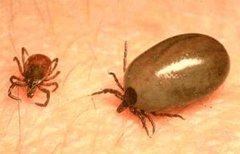 Lyme disease is a tick-borne disease affecting animals and people
living in North America and in Europe. The disease is caused by the
Borrelia bacteria. Lyme disease gets its name from Lyme, Connecticut, USA.
In 1975, the town experienced an outbreak of the disease. The tick
species responsible for transmitting the disease is the deer tick. The
most common antibiotic used to treat Lyme disease is doxycycline.
Lyme disease is a tick-borne disease affecting animals and people
living in North America and in Europe. The disease is caused by the
Borrelia bacteria. Lyme disease gets its name from Lyme, Connecticut, USA.
In 1975, the town experienced an outbreak of the disease. The tick
species responsible for transmitting the disease is the deer tick. The
most common antibiotic used to treat Lyme disease is doxycycline.
Protecting Your Dog from Lyme Disease
If you live in the in the upper Midwestern states, the Atlantic seaboard or the Pacific coastal states and you observe that your dog is not eating well and is limping, then your dog may be infected with Lyme disease. Other signs that your dog may be sick with Lyme disease include fatigue, fever, enlargement of lymph nodes, and weight shifting lameness (where the dog is lame on one leg one day and then another leg another day).
If you suspect that your dog has Lyme disease, immediately have your dog examined by a vet. A blood test will reveal if your dog has Lyme disease or not, and if your dog is infected, the proper antibiotic will be prescribed. In a matter of two days, your dog’s condition will significantly improve.
Treating the disease in its early stages will prevent the development of complications. Lyme disease is known to cause damage to nervous system and the heart. Also, it can result in kidney failure. Finally, the infection can lead to the early development of dog arthritis, or if the dog already has arthritis, it will exacerbate the dog’s condition.
Lyme disease can be prevented. There are vaccines available to prevent infection and they have been proven to be approximately 80% effective. Also, applying one of the proven veterinary flea and tick preventatives such as Frontline or Advantix, will protect your dog from deer ticks. Finally, avoiding tick-infested environments during the most common periods of tick activity, spring and fall, will also help.
| Lyme Disease and Dog Arthritis (PDF) |
